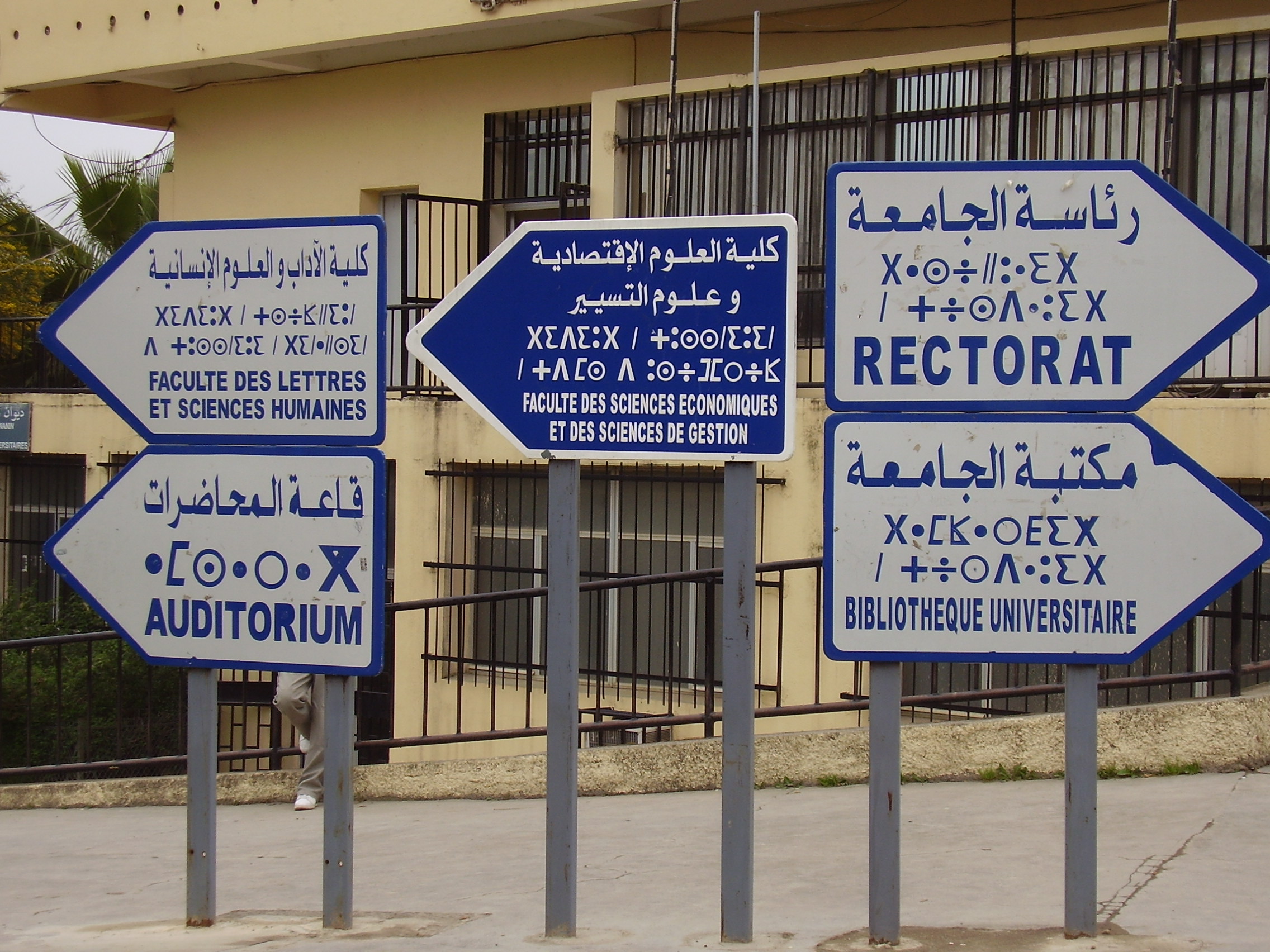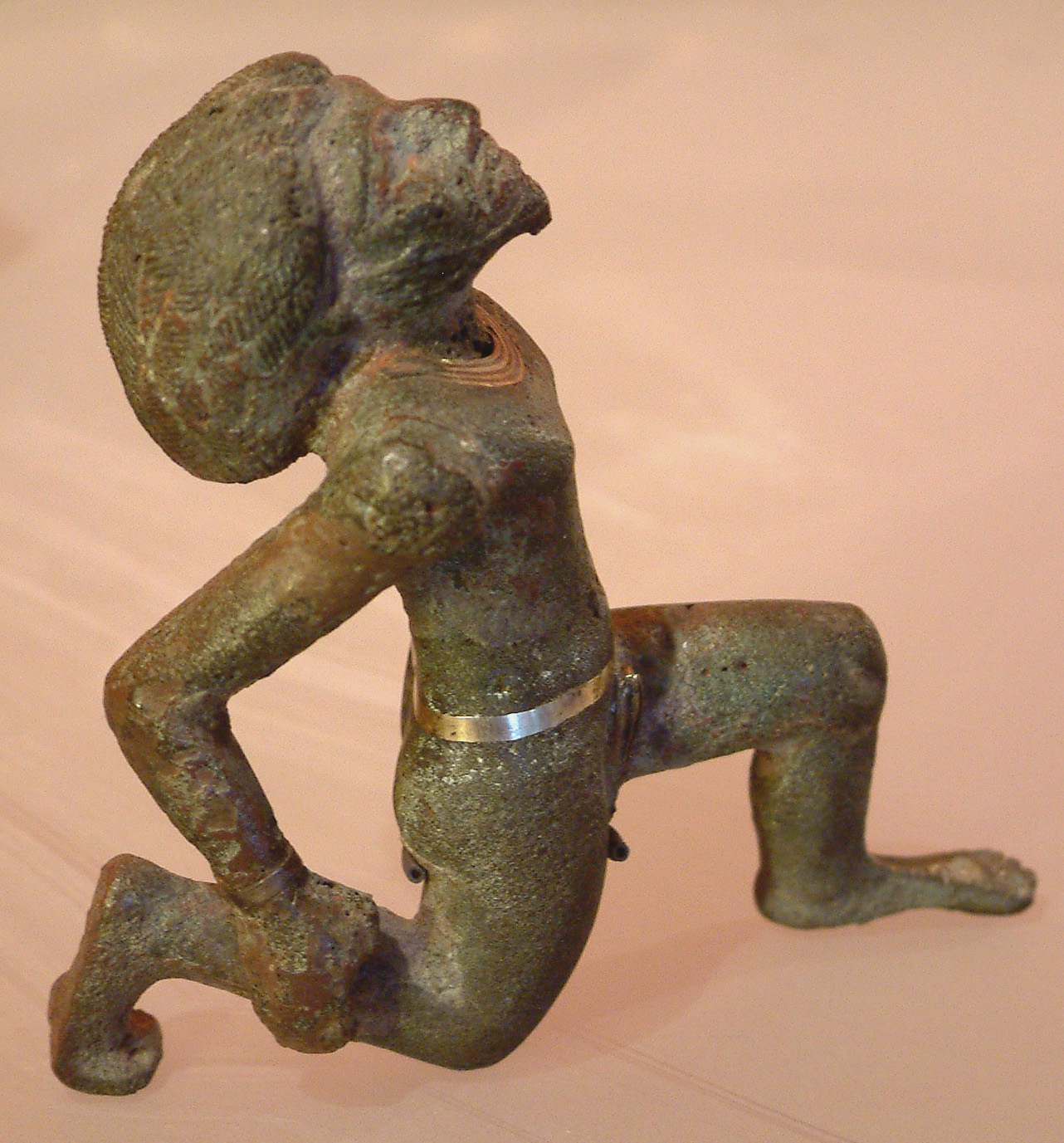|
Northern Berber Languages
The Northern Berber languages are a dialect continuum spoken across the Maghreb, constituting a subgroup of the Berber branch of the Afroasiatic family. Their continuity has been broken by the spread of Arabic, and to a lesser extent by the Zenati group of Northern Berber. The Zenati idioms share certain innovations not found in the surrounding languages; notably a softening of ''k'' to ''sh'' and an absence of ''a-'' in certain words, such as "hand" (''afus'' vs. ''fus''.) Northern Berber languages spoken by over a million people include Shilha, Central Morocco Tamazight, Riff, Shawiya and Kabyle. They fall into three groups: *Moroccan Atlas languages (incl. Shilha, Central Morocco Tamazight) *Zenati languages (incl. Riff, Shawiya) * Kabyle The eastern boundaries of the North Berber varieties are uncertain. Some linguists include the Nafusi and Ghadames languages, while others do not. Most regard Ghadamès as lying outside of Northern Berber, but the '' Ethnologue'' do ... [...More Info...] [...Related Items...] OR: [Wikipedia] [Google] [Baidu] |
Northwest Africa
The Maghreb (; ar, الْمَغْرِب, al-Maghrib, lit=the west), also known as the Arab Maghreb ( ar, المغرب العربي) and Northwest Africa, is the western part of North Africa and the Arab world. The region includes Algeria, Libya, Mauritania (also considered part of West Africa), Morocco, and Tunisia. The Maghreb also includes the disputed territory of Western Sahara (controlled mostly by Morocco and partly by the Sahrawi Arab Democratic Republic) and the Spanish cities Ceuta and Melilla.Article 143. As of 2018, the region had a population of over 100 million people. Through the 18th and 19th centuries, English sources often referred to the region as the Barbary Coast or the Barbary States, a term derived from the demonym of the Berbers. Sometimes, the region is referred to as the Land of the Atlas, referring to the Atlas Mountains, which are located within it. The Maghreb is usually defined as encompassing much of the northern part of Africa, including a ... [...More Info...] [...Related Items...] OR: [Wikipedia] [Google] [Baidu] |
Ghadames Language
Ghadames or Ghadamis (Berber: ''ʕadémis''; ar, غدامس, Libyan vernacular: ''ɣdāməs'', Latin: ''Cidamus, Cydamus'', it, Gadames) is an oasis Berber town in the Nalut District of the Tripolitania region in northwestern Libya. The indigenous language of Ghadames is Ghadamès, a Berber language. Ghadamès, known as 'the pearl of the desert', stands in an oasis. It is one of the oldest pre-Saharan cities and an outstanding example of a traditional settlement. Its domestic architecture is characterized by a vertical division of functions: the ground floor used to store supplies; then another floor for the family, overhanging covered alleys that create what is almost an underground network of passageways; and, at the top, open-air terraces reserved for the women. Geography Ghadames lies roughly to the southwest of Tripoli, near the borders with Algeria and Tunisia. Ghadames borders Illizi Province, Algeria and Tataouine Governorate, Tunisia. The oasis has a populatio ... [...More Info...] [...Related Items...] OR: [Wikipedia] [Google] [Baidu] |
Languages Of Algeria
The official languages of Algeria are Arabic and Tamazight (Berber), as specified in its constitution since 1963 for the former and since 2016 for the latter. Berber has been recognized as a "national language" by constitutional amendment since 8 May 2002. In February, 2016, a constitutional resolution was passed making Berber an official language alongside Arabic. Algerian Arabic and Berber are the native languages of over 99% of Algerians, with Algerian Arabic spoken by about 90% and Berber by 10%."Aujourd'hui, la majorité des Algériens sont arabophones dans une proportion de 72 %. Parmi les Arabophones, c'est l'arabe algérien qui dominent nettement avec 60 % de la population totale et 83,2 % des arabophones. Les autres arabophones parlent le hassaniyya (11,3 %), l'arabe marocain (0,4 %), l'arabe du Sahara (0,1 %), l'arabe égyptien, voire l'arabe irakien. Toutes les variétés d'arabe appartiennent au groupe sémitique de la famille chamito-sémitique. Mais tous les arabo ... [...More Info...] [...Related Items...] OR: [Wikipedia] [Google] [Baidu] |
Languages Of Morocco
There are a number of languages of Morocco. The two official languages are Standard Arabic and Standard Moroccan Berber.2011 Constitution of MoroccFull text of the 2011 Constitution (French) Moroccan Arabic (known as Darija) is the spoken native vernacular. The languages of prestige in Morocco are Arabic in its Classical and Modern Standard Forms and sometimes French, the latter of which serves as a second language for approximately 33% of Moroccans.La Francophonie dans le monde " Archive '' |
Berbers In Tunisia
, image = File:Berber_flag.svg , caption = The Berber ethnic flag , population = 36 million , region1 = Morocco , pop1 = 14 million to 18 million , region2 = Algeria , pop2 = 9 million to ~13 million , region3 = Mauritania , pop3 = 2.9 million , region4 = Niger , pop4 = 2.6 million, Niger: 11% of 23.6 million , region5 = France , pop5 = 2 million , region6 = Mali , pop6 = 850,000 , region7 = Libya , pop7 = 600,000 , region8 = Belgium , pop8 = 500,000 (including descendants) , region9 = Netherlands , pop9 = 467,455 (including descendants) , region10 = Burkina Faso , pop10 = 406,271, Burkina Faso: 1.9% of 21.4 million , region11 = Egypt , pop11 = 23,000 or 1,826,580 , region12 = Tunisia , pop12 ... [...More Info...] [...Related Items...] OR: [Wikipedia] [Google] [Baidu] |
Berbers In Morocco
, image = File:Berber_flag.svg , caption = The Berber ethnic flag , population = 36 million , region1 = Morocco , pop1 = 14 million to 18 million , region2 = Algeria , pop2 = 9 million to ~13 million , region3 = Mauritania , pop3 = 2.9 million , region4 = Niger , pop4 = 2.6 million, Niger: 11% of 23.6 million , region5 = France , pop5 = 2 million , region6 = Mali , pop6 = 850,000 , region7 = Libya , pop7 = 600,000 , region8 = Belgium , pop8 = 500,000 (including descendants) , region9 = Netherlands , pop9 = 467,455 (including descendants) , region10 = Burkina Faso , pop10 = 406,271, Burkina Faso: 1.9% of 21.4 million , region11 = Egypt , pop11 = 23,000 or 1,826,580 , region12 = Tunisia , pop12 ... [...More Info...] [...Related Items...] OR: [Wikipedia] [Google] [Baidu] |
Berbers In Algeria
, image = File:Berber_flag.svg , caption = The Berber ethnic flag , population = 36 million , region1 = Morocco , pop1 = 14 million to 18 million , region2 = Algeria , pop2 = 9 million to ~13 million , region3 = Mauritania , pop3 = 2.9 million , region4 = Niger , pop4 = 2.6 million, Niger: 11% of 23.6 million , region5 = France , pop5 = 2 million , region6 = Mali , pop6 = 850,000 , region7 = Libya , pop7 = 600,000 , region8 = Belgium , pop8 = 500,000 (including descendants) , region9 = Netherlands , pop9 = 467,455 (including descendants) , region10 = Burkina Faso , pop10 = 406,271, Burkina Faso: 1.9% of 21.4 million , region11 = Egypt , pop11 = 23,000 or 1,826,580 , region12 = Tunisia , pop12 ... [...More Info...] [...Related Items...] OR: [Wikipedia] [Google] [Baidu] |
Northern Berber Languages
The Northern Berber languages are a dialect continuum spoken across the Maghreb, constituting a subgroup of the Berber branch of the Afroasiatic family. Their continuity has been broken by the spread of Arabic, and to a lesser extent by the Zenati group of Northern Berber. The Zenati idioms share certain innovations not found in the surrounding languages; notably a softening of ''k'' to ''sh'' and an absence of ''a-'' in certain words, such as "hand" (''afus'' vs. ''fus''.) Northern Berber languages spoken by over a million people include Shilha, Central Morocco Tamazight, Riff, Shawiya and Kabyle. They fall into three groups: *Moroccan Atlas languages (incl. Shilha, Central Morocco Tamazight) *Zenati languages (incl. Riff, Shawiya) * Kabyle The eastern boundaries of the North Berber varieties are uncertain. Some linguists include the Nafusi and Ghadames languages, while others do not. Most regard Ghadamès as lying outside of Northern Berber, but the '' Ethnologue'' do ... [...More Info...] [...Related Items...] OR: [Wikipedia] [Google] [Baidu] |
Mutual Intelligibility
In linguistics, mutual intelligibility is a relationship between languages or dialects in which speakers of different but related varieties can readily understand each other without prior familiarity or special effort. It is sometimes used as an important criterion for distinguishing languages from dialects, although sociolinguistic factors are often also used. Intelligibility between languages can be asymmetric, with speakers of one understanding more of the other than speakers of the other understanding the first. When it is relatively symmetric, it is characterized as "mutual". It exists in differing degrees among many related or geographically proximate languages of the world, often in the context of a dialect continuum. Intelligibility Factors An individual's achievement of moderate proficiency or understanding in a language (called L2) other than their first language (L1) typically requires considerable time and effort through study and practical application if the two l ... [...More Info...] [...Related Items...] OR: [Wikipedia] [Google] [Baidu] |
Dialect
The term dialect (from Latin , , from the Ancient Greek word , 'discourse', from , 'through' and , 'I speak') can refer to either of two distinctly different types of linguistic phenomena: One usage refers to a variety of a language that is a characteristic of a particular group of the language's speakers. Under this definition, the dialects or varieties of a particular language are closely related and, despite their differences, are most often largely mutually intelligible, especially if close to one another on the dialect continuum. The term is applied most often to regional speech patterns, but a dialect may also be defined by other factors, such as social class or ethnicity. A dialect that is associated with a particular social class can be termed a sociolect, a dialect that is associated with a particular ethnic group can be termed an ethnolect, and a geographical/regional dialect may be termed a regiolectWolfram, Walt and Schilling, Natalie. 2016. ''American Engli ... [...More Info...] [...Related Items...] OR: [Wikipedia] [Google] [Baidu] |
Language
Language is a structured system of communication. The structure of a language is its grammar and the free components are its vocabulary. Languages are the primary means by which humans communicate, and may be conveyed through a variety of methods, including spoken, sign, and written language. Many languages, including the most widely-spoken ones, have writing systems that enable sounds or signs to be recorded for later reactivation. Human language is highly variable between cultures and across time. Human languages have the properties of productivity and displacement, and rely on social convention and learning. Estimates of the number of human languages in the world vary between and . Precise estimates depend on an arbitrary distinction (dichotomy) established between languages and dialects. Natural languages are spoken, signed, or both; however, any language can be encoded into secondary media using auditory, visual, or tactile stimuli – for example, writ ... [...More Info...] [...Related Items...] OR: [Wikipedia] [Google] [Baidu] |
Ethnologue
''Ethnologue: Languages of the World'' (stylized as ''Ethnoloɠue'') is an annual reference publication in print and online that provides statistics and other information on the living languages of the world. It is the world's most comprehensive catalogue of languages. It was first issued in 1951, and is now published by SIL International, an American Christian non-profit organization. Overview and content ''Ethnologue'' has been published by SIL International (formerly known as the Summer Institute of Linguistics), a Christian linguistic service organization with an international office in Dallas, Texas. The organization studies numerous minority languages to facilitate language development, and to work with speakers of such language communities in translating portions of the Bible into their languages. Despite the Christian orientation of its publisher, ''Ethnologue'' isn't ideologically or theologically biased. ''Ethnologue'' includes alternative names and autonyms, t ... [...More Info...] [...Related Items...] OR: [Wikipedia] [Google] [Baidu] |




